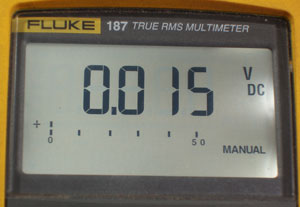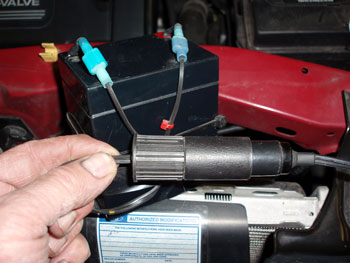er, a throttle position sensor ground circuit should not display more than a 50 mV voltage drop in its ground circuit. Systems like the EEC-IV might test higher than 50 mV, but should nevertheless remain under 100 mV.

Fuse Testing
Modern vehicles have multiple fuse boxes that can collectively contain more than 100 fuses, each of which can power multiple circuits. Because circuit voltage is the most important issue in the correct operation of any modern electrical or electronic component, a technician should use an accurate DMM to test each fuse for continuity and battery voltage. Because the vehicle’s owner’s manual generally contains the most accurate fuse function data, that information should be used to determine the circuits affected by low voltage.
One of the most common examples of trouble codes caused by low circuit voltage can be found on late 1990s General Motors trucks equipped with automatic transmissions. On most of these vehicles, the #20 instrument panel fuse powers the transmission shift solenoids. Unfortunately, the ignition switches in these vehicles develop resistance in their contacts and the first intermittent failure usually occurs as a partial loss of voltage at the #20 fuse. Cold weather aggravates this condition because the grease congeals in the switch and may hold the contacts apart.
The symptoms of a bad ignition switch are a transmission that intermittently defaults to an intermediate gear and a diagnostic memory that’s loaded with shift solenoid-related trouble codes. Typically, these codes will start to appear when circuit voltage falls below 10 volts.

Cold Weather Performance Issues
Any vehicle with a cold driveability complaint should automatically undergo a battery capacity test. I’ve diagnosed a number of Chrysler-built vehicles with cold driveability complaints, the majority of which were caused not by a mysterious computer problem, but by a battery with a dead cell that produced less than 10.0 volts KOEO.
When the battery produces less than 10 volts during cold-cranking, the low battery voltage can erase the adaptive memory in the PCM containing the operating altitude and other pertinent start-up data. The loss of adaptive memory forces the PCM to go into a re-learn process immediately after start-up, which temporarily “cures” the cold-driveability problem during engine warm-up. For no-code driveability issues, keep in mind that a weak battery might also erase the diagnostic memory during cranking. Whatever the case, minimum cranking voltage is critical to the correct operation of any computer-controlled system.
Battery Testing
On rare occasion, I’ve run encountered cases in which brand-new batteries with defective cell connections would cause cold starting and cold driveability complaints. Because most new batteries can test as high as 125% of rated Cold Cranking Amperage (CCA), a new battery with a dead cell can occasionally pass a carbon pile and an electronic cell test while still causing cranking, no-start and cold driveability complaints.
For this reason, using a DMM to test battery state-of-charge (SOC) should be standard operating procedure for testing cold-weather battery failures. The open-circuit voltage (OCV), for example, should be about 12.8 volts when the battery has a surface charge. Turning on the headlamps for at least five minutes should remove the surface charge and reduce OCV to about 12.66 volts. If OCV remains higher, the battery is probably low on water.
If OCV drops below 12.66 volts when the surface charge is removed, the OCV on a good battery should gradually rise back to at least 12.6 volts after a few minutes of rest.
OCV is important because an OCV of 12.3 volts indicates that the charge on a battery with a core electrolyte temperature of 70° F is only about 60% of normal. An OCV of 12 volts indicates that the charge is only about 20% of normal and generally not sufficient to crank the engine.
As a point of reference, remember that a battery with an electrolyte temperature of 0° F produces only about 40% of its rated capacity. If you’re in doubt about cold-weather battery capacity, test the battery terminal voltage while cranking the engine on a cold morning. If the battery terminal voltage drops below 9.1 volts during cranking at 30° F, there’s a good chance that the battery itself might be causing the unusual cold driveability or no-code performance complaint.
The Min-Max Feature
It’s always important for any diagnostic tech to occasionally review the features of his DMM by re-reading his user’s manual. For example, techs often forget the advantages of using their DMM’s minimum/maximum recording feature to diagnose electrical circuits. A good illustration is troubleshooting a code 52 on a 1994 Toyota pickup that was caused by a circuit failure in the 22RE engine’s knock sensor circuit. In this instance, available technical service bulletins and archival data indicated that the wiring harness to the detonation sensor on this application is particularly sensitive to bad connections and wire breakage due to hardened insulation.
Because the knock sensor on this application is a high frequency unit that requires special diagnostic procedures, the diagnostic issue here is verifying that the knock sensor is working correctly before dealing with any intermittent wiring issues. One set of archival information indicates that a good knock sensor for this application will produce between 7,000 and 8,000 Hertz (Hz) when the engine is snap-throttled at 3,500 rpm.
The real-world problem is that it’s tough to read the peak frequency during the snap-throttle process because the numbers on the display blur. In this case, the simplest procedure was to use the DMM’s min/max feature to capture the peak Hz reading. A second DMM with a tachometer lead attached was also used to measure the critical 3,500 rpm starting point for the snap throttle test. As might be expected, the knock sensor produced about 7,500 Hz at a 3,500 rpm snap throttle.
After verifying knock sensor condition, we checked the integrity of the knock sensor circuit by using the min/max feature to measure variations in the 0.015-volt bias present in the knock sensor wire when it was removed from the knock sensor. As recorded on the min/max scale, a wiggle and stress test at the connector caused the reference voltage to switch from 0.015 volts to 0 volts. Cleaning and tightening the connector remedied the problem.
Testing Parasitic Draw
Although an inductive current probe can be used to test parasitic draw, the real-life issue on many modern vehicles is that multiple cables are attached to both the positive and negative battery terminals. The other practical problem is that, once a battery terminal is disconnected and reattached, various on-board electronics modules can require hours to go into the “sleep” mode, which makes it difficult to test for parasitic draw during a normal work day if the battery circuit has once been broken.
A more practical solution is to use a small auxiliary battery to power the vehicle’s electronics while the negative battery terminal is disconnected. Although it’s much easier to attach an inductive current lead to the single positive lead coming from the auxiliary battery, a far more accurate parasitic draw reading can be achieved by using the DMM’s ammeter leads to directly measure current flowing from the battery, through the DMM, and into the vehicle’s electronic system. That can be done by starting with the DMM initially set to the 10-ampere scale and connecting the DMM in series with the positive or negative battery cable and the battery terminal.
When the auxiliary battery is disconnected, the DMM will produce an absolutely accurate parasitic draw reading that isn’t influenced by magnetic fields created by nearby wiring or accessories. Because the power-off feature on many professional DMMs can also be adjusted to as high as 24 hours, it’s possible to capture any overnight module wake-ups.
A DMM Summary
In this segment, we have covered a few of the most practical and convenient applications of the professional DMM. On the next installment, we’ll explore even more applications in which the accuracy and convenience of the professional DMM complements even the most sophisticated scan tool or lab scope.













